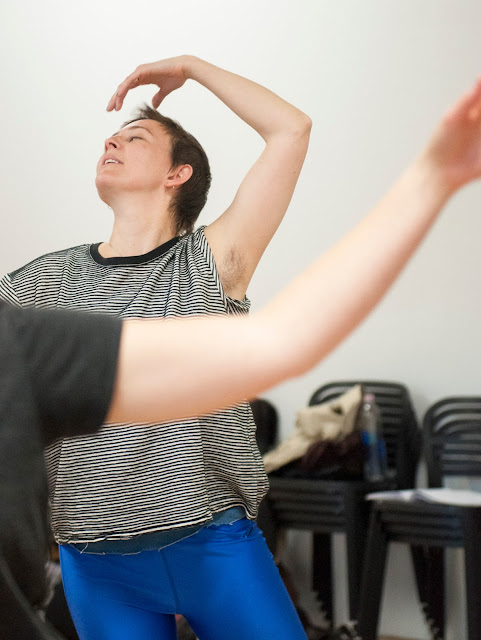“It’s important to laugh,” says Katy Pyle. “Today I want to laugh.”
Katy is the founder and Artistic Director of Ballez, a dance company and technique that rewrites traditionally gendered ballet narratives to include previously shut out gender expressions and non-gendered movements. It promotes inclusivity, diversity, positivity. As Pyle eloquently writes, it “invites everyone to witness and celebrate the history and performances of lesbian, queer, and transgender people,” and “the virtuosity of complexly gendered embodiment, energetic eloquence, queer coding, and the magical adaptability of expression that Ballez dancers have cultivated through their lives as a way to survive and thrive.”
Since 2011, Katy has been teaching the original “Adult Ballez Class” at Brooklyn Arts Exchange in Park Slope. Katy and her co-teachers have now taught all over the country, from their regular weekly classes at Brooklyn Arts Exchange (or BAX) to Yale University, Bennington College, NYU, Sarah Lawrence College, and many other institutions. They have also been featured in The New York Times, Teen Vogue, and Dance Magazine, among others.
In a cafe, Katy discusses feeling artistically stuck and blocked in relation to the country’s current political climate. For a long time, she danced only in her hallway, in natural, improvisational movement she would film and put on her Instagram, and with the Ballez classes she would teach every week. But she is feeling herself unravel a bit more these days, and has begun a series of “channels” as she calls them, in which she performs alternative versions of classic choreographers’ work in drag—most recently, she tackled George Balanchine.
Every time Katy tells me something new she’s thinking about or experimenting with or creating, my jaw drops in awe and “You’re a genius!” spills from my mouth. But I really believe it. I think it takes a special kind of person to see a void in the art world then expertly fill it in a way that only they ever can. Since I first photographed Ballez in 2013, it’s been delightful and staggeringly wonderful to see it grow.
Today, we are heading back to Katy’s roots. After the cafe, we make our way to BAX where she meets up with Madison Krekel, a Ballez company member who will be co-teaching Adult Ballez that day. They make notes for what they want to accomplish, like partner and barre work, and a laughing exercise Katy is especially invested in. In these times, she tells me, she needs a laugh and a Ballez class to keep her spirits up.
Students file in and class starts. Everyone shares their name and pronoun of choice, then the laughter exercise begins, everyone leaning on each other’s stomachs and just starting to laugh and laugh. The lightness and the happiness that comes from it radiates through the length of the class, from barre work set to 4 Non-Blondes and Prince to original Ballez choreography set to Tchaikovsky’s Sleeping Beauty. At first some people are hesitant, but slowly they begin to open up—they watch, they smile, they dance.
Katy is the founder and Artistic Director of Ballez, a dance company and technique that rewrites traditionally gendered ballet narratives to include previously shut out gender expressions and non-gendered movements. It promotes inclusivity, diversity, positivity. As Pyle eloquently writes, it “invites everyone to witness and celebrate the history and performances of lesbian, queer, and transgender people,” and “the virtuosity of complexly gendered embodiment, energetic eloquence, queer coding, and the magical adaptability of expression that Ballez dancers have cultivated through their lives as a way to survive and thrive.”
Since 2011, Katy has been teaching the original “Adult Ballez Class” at Brooklyn Arts Exchange in Park Slope. Katy and her co-teachers have now taught all over the country, from their regular weekly classes at Brooklyn Arts Exchange (or BAX) to Yale University, Bennington College, NYU, Sarah Lawrence College, and many other institutions. They have also been featured in The New York Times, Teen Vogue, and Dance Magazine, among others.
In a cafe, Katy discusses feeling artistically stuck and blocked in relation to the country’s current political climate. For a long time, she danced only in her hallway, in natural, improvisational movement she would film and put on her Instagram, and with the Ballez classes she would teach every week. But she is feeling herself unravel a bit more these days, and has begun a series of “channels” as she calls them, in which she performs alternative versions of classic choreographers’ work in drag—most recently, she tackled George Balanchine.
Every time Katy tells me something new she’s thinking about or experimenting with or creating, my jaw drops in awe and “You’re a genius!” spills from my mouth. But I really believe it. I think it takes a special kind of person to see a void in the art world then expertly fill it in a way that only they ever can. Since I first photographed Ballez in 2013, it’s been delightful and staggeringly wonderful to see it grow.
Today, we are heading back to Katy’s roots. After the cafe, we make our way to BAX where she meets up with Madison Krekel, a Ballez company member who will be co-teaching Adult Ballez that day. They make notes for what they want to accomplish, like partner and barre work, and a laughing exercise Katy is especially invested in. In these times, she tells me, she needs a laugh and a Ballez class to keep her spirits up.
Students file in and class starts. Everyone shares their name and pronoun of choice, then the laughter exercise begins, everyone leaning on each other’s stomachs and just starting to laugh and laugh. The lightness and the happiness that comes from it radiates through the length of the class, from barre work set to 4 Non-Blondes and Prince to original Ballez choreography set to Tchaikovsky’s Sleeping Beauty. At first some people are hesitant, but slowly they begin to open up—they watch, they smile, they dance.
Follow Katy on Instagram.




















